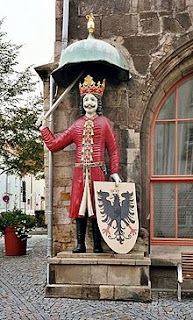While
visiting my brother in Spain, we took one excursion to the Southern edge of the
Iberian Peninsula which is the British territory of Gibraltar. Beside the military operations it
contains the famous rock of Gibraltar which rises over 400 meters above sea level.
We
went there on a breezy day in May and since I wanted to see into Africa, we
decided to take the cable car to the top of the mountain. In the early 12th century, the Southern
Iberian Peninsula was conquered by the Mores who left fortresses and castles
including one on the lower part of the Rock of Gibraltar. We were able to see it as we ascended in
cable car.
When we arrived at the top we
were greeted by the rare Barbary Macaques, the only free living “monkeys” in Europe.
Even though they have their feeding places, they like to sneak treats
from the tourists. They jump unto the
cars or buses and playfully show off their tailless bodies. We were watching one older Barbary enjoy a
box of crackers, while a younger monkey was eyeing him and trying to get his
share. Anytime the younger animal got
close to the older one he would hiss at the young creature and scare him
off.

We
went to the observation plateau and marveled at the beautiful scenery below and
above where seagulls took pleasure in the currents of the wind coming up the
mountain. I was thinking of “Jonathan Livingston Seagull’s story.” While I was trying to take a picture of a
seagull above my head I notice that my balance wasn’t so steady, considering
that I was standing with pretty much only air around me. The wind was blowing hard and I had to hold
on to the railing of the observatory.

After we had seen all the pretty flowers,
saw some more monkeys and took pictures of the “other continent” on the other
side of the strait of Gibraltar ( the separation is only about 20 miles, and on
that clear day we were able to see the mountains of Morocco) we decided to take
the cable car back down. We were lucky
as one car was just leaving and the operator even opened the door again for us,
only to learn a few minutes later that they had to close down the operation due
to high winds. We were told to wait in
the coffee shop for a bus to transport us down the mountain. Since all the roads up the mountain are only
one-way, we had to wait 3 hours for our turn, with the number 3 printed on our
tickets. While waiting we enjoyed free
coffee, water and finally were given a certificate that showed us being present
at the “Top of the Rock.”

Even
though we were never in any danger, I was very glad when I had solid ground
again under my feed when we arrived safely by bus at the bottom of the cable
care station.
 As
we as we are celebrating this Memorial Day in these United States of America,
as we are honoring our brave soldiers who served in foreign lands, I want to
add reflecting and praying for those men and women who became heroes by
default. I am thinking of those whom I
wrote about in one of my last blogs, those
who lost their lives working in concentration camps. We often hear about the 6,000 Jews who
perished in the gas chambers of Auschwitz, Buchenwald or Sachsenhausen. It was the most cruel and senseless crime
ever committed on humans. None-the-less
let us not forget the other captives, who came from more than 21 countries who
died working in the dark tunnels of the Kohnstein mountain. They didn’t commit any crime; they became
prisoners of war, many of them educated engineers and highly qualified men who
were used by a brutal regime. Or the
many other humans who have fallen into slavery or tyranny at the mercy of
bullies and dictators. All of them had
families, lovers, children, who often didn’t know how their loved one
died. They also deserve to be mourned
and celebrated for their sacrifices.
As
we as we are celebrating this Memorial Day in these United States of America,
as we are honoring our brave soldiers who served in foreign lands, I want to
add reflecting and praying for those men and women who became heroes by
default. I am thinking of those whom I
wrote about in one of my last blogs, those
who lost their lives working in concentration camps. We often hear about the 6,000 Jews who
perished in the gas chambers of Auschwitz, Buchenwald or Sachsenhausen. It was the most cruel and senseless crime
ever committed on humans. None-the-less
let us not forget the other captives, who came from more than 21 countries who
died working in the dark tunnels of the Kohnstein mountain. They didn’t commit any crime; they became
prisoners of war, many of them educated engineers and highly qualified men who
were used by a brutal regime. Or the
many other humans who have fallen into slavery or tyranny at the mercy of
bullies and dictators. All of them had
families, lovers, children, who often didn’t know how their loved one
died. They also deserve to be mourned
and celebrated for their sacrifices.













